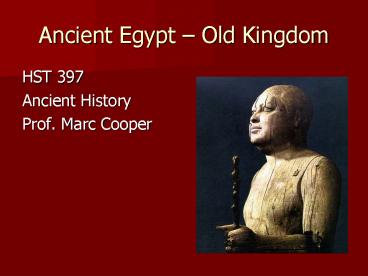Ancient Egypt Old Kingdom - PowerPoint PPT Presentation
1 / 14
Title:
Ancient Egypt Old Kingdom
Description:
Origins of farming in Africa ... and the growing of sorghum and yams (7500 ... peoples cultivate gourds and watermelons, domesticate donkeys and cattle (from ... – PowerPoint PPT presentation
Number of Views:278
Avg rating:3.0/5.0
Title: Ancient Egypt Old Kingdom
1
Ancient Egypt Old Kingdom
- HST 397
- Ancient History
- Prof. Marc Cooper
2
Origins of farming in Africa
- Sahara region used to be grassy steppe lands with
water (10,000 BCE) - Abundant hunting, fishing, wild grains
- Eastern Sudan begins to herd cattle and collect
grains (9000 BCE) - Permanent settlements and the growing of sorghum
and yams (7500 BCE) - Small states with semi-divine rulers (5000 BCE)
- Climate becomes hotter and drier after 5000 BCE
- People are driven into river regions Wadis
leading to Nile - Annual flooding makes rich soil for agriculture
but swampy - Farmers begin clearing and draining Nile swamps
after 4500 BCE - Earliest farming villages in Egypt show influence
from southwest Asia and Nubia
3
Egypt and the Sinai
4
Egypt and Nubia "gifts of the Nile"
- Egypt--lower third of Nile River Nubia--middle
third of Nile - After 5000 B.C.E. peoples cultivate gourds and
watermelons, domesticate donkeys and cattle (from
Sudan), and grow wheat and barley (from
Mesopotamia) - Agriculture easy in Egypt (due to Nile flooding)
but more work in Nubia - States begin to emerge by 4000 B.C.E., small
kingdoms by 3300 B.C.E.
5
Predynastic Egypt ca. 3300 BCE
- Early Kingdoms
- South (Valley)
- Abydos Osiris/Isis
- Hierakleopolis Horus
- North (Delta)
- Heliopolis - Re
- Buto Set/Neith
6
The unification of Egypt
- Egypt, large and prosperous state by 3100 B.C.E.
- Menes/Narmer unites Upper and Lower Egypt
- Establishes Memphis as the capital city
- Narmer palette seems to celebrate unification
- Pharaoh, absolute ruler and god owns all land
- Archaic Period (3100-2660 B.C.E.)
- Old Kingdom (2660-2160 B.C.E.)
- Great pyramids of Giza built during this period
Khufus the largest - Violence between Egypt and Nubia (Egypt dominates
from 3000-2400 B.C.E.) - Nubia later develops into Kingdom of Kush
- Interaction through diplomacy, Nubian
mercenaries, and intermarriage
7
Nubian evidence for early pharaohs
8
Narmer Palette
9
Old Kingdom
- Peaceful period
- No standing army
- No foreign conquest
- Armed trading expeditions to Nubia
- Reconnaissance in strength in Palestine
- Kingship
- King is netcher nefer, the good god
- Royal tombs larger than those of gods
- Noble tombs near royal tombs
- King is thought to own everything
- King is thought to do everything
- Centralized bureaucracy executed royal will
- Most bureaucrats were directly responsible to king
10
Djosers step pyramid
11
Giza Pyramids
12
Pyramids
Bent Pyramid
13
What were pyramids?
- Burial place of pharaohs
- Included mortuary temples for the continued
worship of dead kings - Huge make-work projects which kept thousands of
workers busy all year long - Protected the dead kings body so that he could
be Osiris and make plants germinate
14
Why did the Old Kingdom fall?
- 5th and 6th dynasty kings paid out vast sums to
keep up the cults of long dead kings - Power decentralized as bureaucracy grows
- Weather and foreign enemies may have become a
problem































